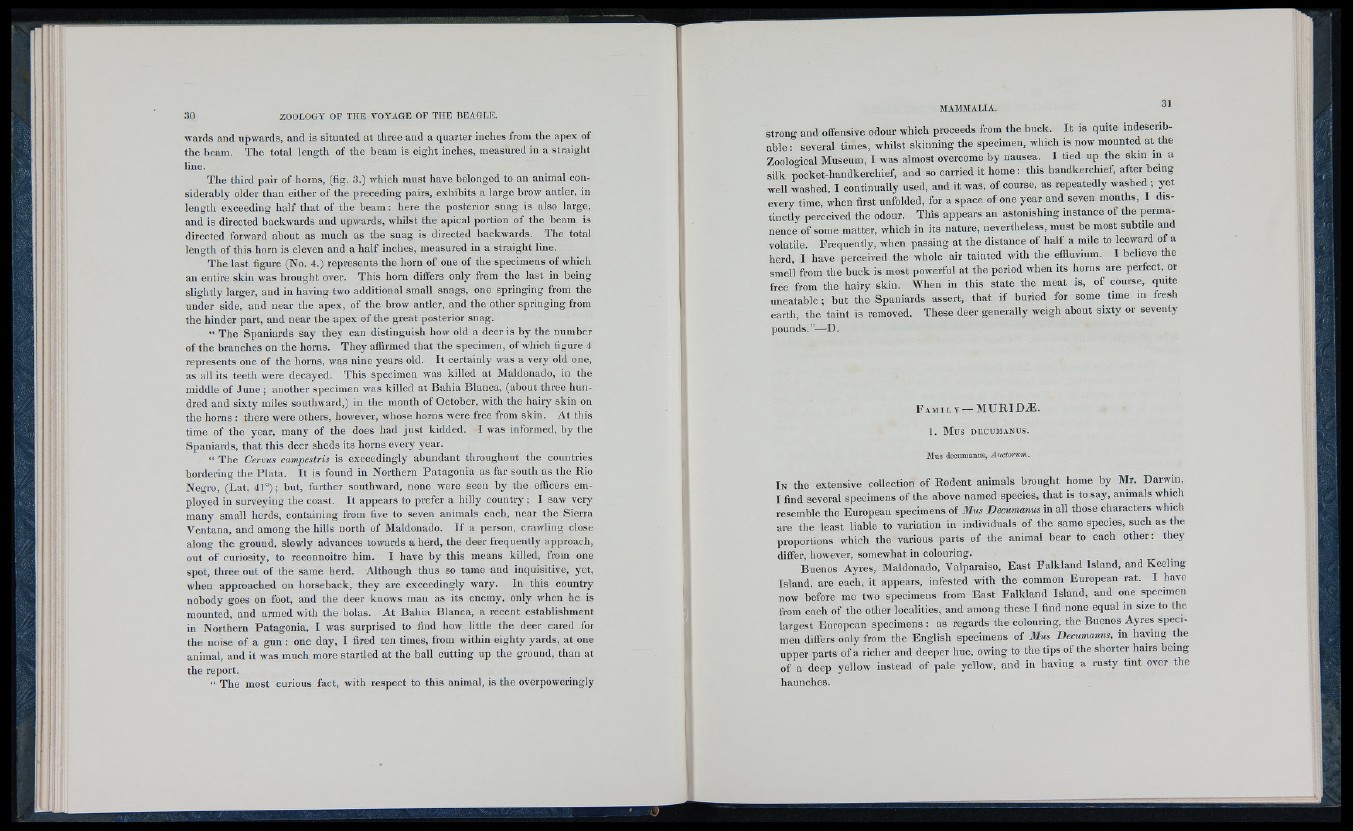
wards aud upwards, and is situated at three and a quarter inches from the apex of
the beam. The total length of the beam is eight inches, measured in a straight
line.
The third pair of horns, (fig. 3.) which must have belonged to an animal considerably
older than either of the preceding pairs, exhibits a large brow antler, in
length exceeding half that of the beam: here the posterior snag is also large,
and is directed backwards and upwards, whilst the apical portion oi the beam is
directed forward about as much as the snag is directed backwards. The total
length of this horn is eleven and a half inches, measured in a straight line.
The last figure (No. 4.) represents the horn of one of the specimens of which
an entire skin was brought over. This horn differs only from the last in being
slightly larger, and in having two additional small snags, one springing from the
under side, and near the apex, of the brow antler, and the other springing from
the hinder part, and near the apex of the great posterior snag.
“ The Spaniards say they can distinguish how old a deer is by the number
of tlie branches on the horns. They affirmed that the specimen, of which figure 4
represents one of the horns, was nine years old. It certainly was a very old one,
as all its teeth were decayed, Tliis specimen was killed at Maldonado, in the
middle of June ; another specimen was killed at Bahia Blanca, (al)out three hundred
and sixty miles southward,) in the month of October, with the hairy skin on
the horns : there were others, however, whose horns were free from skin. At this
time of the year, many of the does had just kidded. I was informed, by the
Spaniards, that this deer sheds its horns every year.
“ The Cervus campestris is exceedingly abundant throughout the countries
bordering the Plata. It is found in Northern Patagonia as far south as the Rio
Negro, (Lat. 41°); hut, further southward, none were seen by the officers employed
in surveying the coast. It appears to prefer a hilly country ; I saw very
many small herds, containing from five to seven animals each, near the Sierra
Ventana, and among the hills north of Maldonado. If a person, crawling close
along the ground, slowly advances towards a herd, the deer frequently approach,
out of curiosity, to reconnoitre him. I have by this means killed, from one
spot, three out of the same herd. Although thus so tame and inquisitive, yet,
when approached on horseback, they are exceedingly wary. In this country
nobody goes on foot, and the deer knows man as its enemy, only when he is
mounted, and armed with the holas. At Bahia Blanca, a recent establishment
in Northern Patagonia, I was surprised to find how little the deer cared for
the noise of a gun ; one day, I fired ten times, from within eighty yards, at one
animal, and it was much more startled at the ball cutting up the ground, than at
tlie report.
“ The most curious fact, with respect to this animal, is the overpoweringly
strong and offensive odour which proceeds from the buck. It is quite indescribable
: several times, whilst skinning the specimen, which is now mounted at the
Zoological Museum, I was almost overcome by nausea. 1 tied up the skm in a
silk pocket-handkerchief, and so carried it home: this handkerchief, after being
well washed, I continually used, and it was, of course, as repeatedly washed ; yet
every time, when first unfolded, for a space of one year and seven months, I distinctly
perceived the odour. This appears an astonishing instance of the permanence
of some matter, which in its nature, nevertheless, must be most subtile and
volatile. Frequently, when passing at the distance of half a mile to leeward of a
herd, I have perceived the whole air tainted with the effluvium. I believe the
smell from the buck is most powerful at the period when its horns are perfect, or
free from the hairy skin. When in this state the meat is, of course, quite
uneatable ; hut the Spaniards assert, that if buried for some time m fresh
earth, the taint is removed. These deer generally weigh about sixty or seventy
pounds.”—D.
F a m i l y — M U R I D i E .
1 . M u s DECUMANUS.
5Ius deciimanus, Auctorum.
In the extensive collection of Rodent animals brought home by Mr. Darwin,
I find several specimens of the above named species, ffiat is to say, animals which
resemble the European specimens of Mus Decumanus in all those characters which
are the least liable to variation in individuals of the same species, such as the
proportions which the various parts of the animal bear to each other: they
differ, however, somewhat in colouring.
Buenos Ayres, Maldonado, Valparaiso, East Falkland Island, and Keeling
Island, are each, it appears, infested with the common European rat. I have
now before me two specimens from East Falkland Island, and one specimen
from each of the other localities, and among these I find none equal in size to the
largest European specimens : as regards the colouring, the Buenos Ayres specimen
differs only from the English specimens of Mtts Decumanus, in haying the
upper parts of a richer and deeper hue, owing to the tips of the shorter hairs being
of a deep yellow instead of pale yellow, and in having a rusty tint over the
haunches.